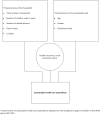Catastrophic health care expenditure in Myanmar: policy implications in leading progress towards universal health coverage
- PMID: 31362749
- PMCID: PMC6664746
- DOI: 10.1186/s12939-019-1018-y
Catastrophic health care expenditure in Myanmar: policy implications in leading progress towards universal health coverage
Abstract
Background: Around the world, millions of people are impoverished due to health care spending. The highest catastrophic health expenditures are found in countries in transition. Our study analyzes the extent of financial protection by estimating the incidence of catastrophic health care expenditure in Myanmar and its association with sociodemographic factors.
Methods: We performed a secondary analysis of data from the household surveys conducted by the Livelihoods and Food Security Trust Fund (LIFT) in 2013 and 2015 in Myanmar. To estimate the magnitude of catastrophic health care expenditure, we applied the definition of catastrophic payment proposed by the World Health Organization (WHO); a household's out-of-pocket payment for health care is considered catastrophic if it exceeds 40% of the household capacity to pay. We also examined the changes in catastrophic payments at three different threshold levels (20, 30, 40%) with one equation allowing for a negative capacity to pay (modified WHO approach) and another equation with adjusted negative capacity to pay (standard WHO approach).
Results: In 2013, the incidence of catastrophic expenditure was 21, 13, 7% (standard WHO approach) and 48, 43, 41% (modified WHO approach) at the 20, 30, 40% threshold level respectively, while in 2015, these estimates were 18, 8, 6% (standard WHO approach) and 47, 41, 39% (modified WHO approach) respectively. Geographical location, gender of the household head, total number of household members, number of children under 5, and number of disabled persons in the household were statistically significantly associated with catastrophic health care expenditures in both studied years 2013 and 2015. Education of household head was statistically significantly associated with catastrophic health expenditure in 2013. We found that the incidence of catastrophic expenditures varied by the approach used to estimate expenditures.
Conclusions: Although the level of catastrophic health care expenditure varies depending on the approach and threshold used, the problem of catastrophic expenditures in Myanmar cannot be denied. The government of Myanmar needs to scale up the current Social Security Scheme (SSS) or establish a new financial protection mechanism for the population. Vulnerable groups, such as households with a household head with a low-level of education, households with children under the age of 5 years or disabled persons, and low-income households should be prioritized by policymakers to improve access to essential health care.
Conflict of interest statement
The authors declare that they have no competing interests among the authors.
Figures
References
-
- World Health Organization . Designing health financing system to reduce catastrophic health expenditure. 2005.
-
- Global Health Observatory data repository. 2015 [cited Nov 2018]. Available from: http://apps.who.int/gho/data/node.main.75.
Publication types
MeSH terms
LinkOut - more resources
Full Text Sources


